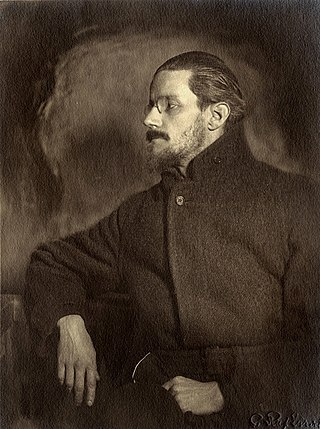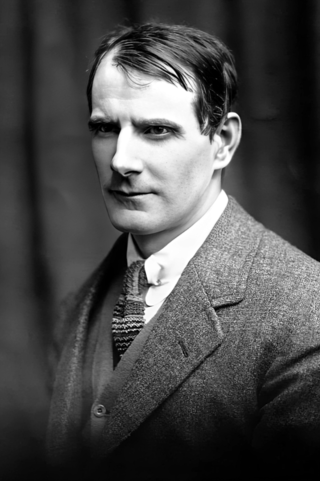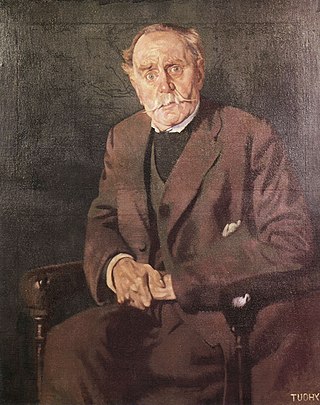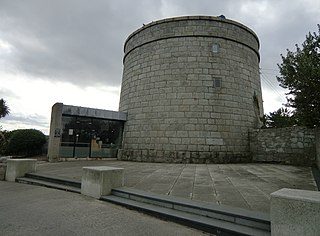
James Augustine Aloysius Joyce was an Irish novelist, poet and literary critic. He contributed to the modernist avant-garde movement and is regarded as one of the most influential and important writers of the 20th century. Joyce's novel Ulysses (1922) is a landmark in which the episodes of Homer's Odyssey are paralleled in a variety of literary styles, particularly stream of consciousness. Other well-known works are the short-story collection Dubliners (1914), and the novels A Portrait of the Artist as a Young Man (1916) and Finnegans Wake (1939). His other writings include three books of poetry, a play, letters, and occasional journalism.

The Abbey Theatre, also known as the National Theatre of Ireland, in Dublin, Ireland, is one of the country's leading cultural institutions. First opening to the public on 27 December 1904, and moved from its original building after a fire in 1951, it has remained active to the present day. The Abbey was the first state-subsidized theatre in the English-speaking world; from 1925 onwards it received an annual subsidy from the Irish Free State. Since July 1966, the Abbey has been located at 26 Lower Abbey Street, Dublin 1.

Seán O'Casey was an Irish dramatist and memoirist. A committed socialist, he was the first Irish playwright of note to write about the Dublin working classes.

Dorset Street is an important thoroughfare on the north side of Dublin, Ireland, and was originally part of the Slighe Midh-Luchra, Dublin's ancient road to the north that begins where the original bridging point at Church Street is today. Subsequently, yet prior to the street being given its current name in the 18th century, the road was known as Drumcondra Lane and was shown on maps as such. It is divided into Dorset Street Lower and Dorset Street Upper.

Oliver Joseph St. John Gogarty was an Irish poet, author, otolaryngologist, athlete, politician, and conversationalist. He served as the inspiration for Buck Mulligan in James Joyce's novel Ulysses.

John Stanislaus Joyce was the father of writer James Joyce, and a well known Dublin man about town. The son of James and Ellen Joyce, John Joyce grew up in Cork, where his mother's family, which claimed kinship to "Liberator" Daniel O'Connell, was quite prominent.
The Irish Literary Revival was a flowering of Irish literary talent in the late 19th and early 20th century. It includes works of poetry, music, art, and literature.

Padraic Colum was an Irish poet, novelist, dramatist, biographer, playwright, children's author and collector of folklore. He was one of the leading figures of the Irish Literary Revival.

F. J. McCormick was an Irish actor who became known for his work at Dublin's Abbey Theatre. He acquired the stage name F.J. McCormick to disguise his identity from his current and future employers, and to avoid parental disapproval. He joined the Abbey at age 19, and acted in some 500 productions there. He is especially remembered for his work in the plays of Seán O'Casey.

Sandycove is a suburb of Dublin, Ireland. It is southeast of Dún Laoghaire and Glasthule, and northwest of Dalkey. It is a popular seaside resort and is well known for its bathing place, the Forty Foot, which in the past was reserved for men only but is now available for mixed bathing. The locale features in the opening of Ulysses by James Joyce.
Ulick O'Connor was an Irish writer, historian and critic.
James Gogarty (1890–1921), was an Irish political figure. He took part in the Easter Rising in 1916; and was the first known Irish Republican Brotherhood (IRB) casualty of the Irish War of Independence.
Malachi Roland St. John "Buck" Mulligan is a fictional character in James Joyce's 1922 novel Ulysses. He appears most prominently in episode 1 (Telemachus), and is the subject of the novel's famous first sentence: "Stately, plump Buck Mulligan came from the stairhead, bearing a bowl of lather on which a mirror and a razor lay crossed."

The James Joyce Tower and Museum is a Martello tower in Sandycove, Dublin, where James Joyce spent six nights in 1904. The opening scenes of his 1922 novel Ulysses take place here, and the tower is a place of pilgrimage for Joyce enthusiasts, especially on Bloomsday. Admission is free.
The Shadow of a Gunman is a 1923 tragicomedy play by Seán O'Casey set during the Irish War of Independence. It centres on the mistaken identity of a building tenant who is thought to be an IRA assassin.
Peter Costello is an author and editor, described by the American critic Robert Hogan in the Greenwood Dictionary of Irish Literature as “a contemporary embodiment” of the “tradition in Irish literature of the independent scholar, who has an erudition embarrassing to the professional academic”.

The Plough and the Stars is a 1937 American drama film directed by John Ford and starring Barbara Stanwyck and Preston Foster. It is based on the play of the same name written by Seán O'Casey.

As I Was Going Down Sackville Street: A Phantasy in Fact is a book by Oliver St. John Gogarty. Published in 1937 by Rich & Cowan in the UK and by Reynal and Hitchcock in the US, it was Gogarty's first extended prose work and was described by its author as "something new in form: neither a 'memoir' nor a novel". Its title is taken from an obscure Dublin ballad of the same name, which was "rescued from oblivion and obloquy" by Gogarty's erstwhile friend James Joyce, who recited it for Gogarty in 1904 after hearing it in inner city Dublin.
Robert P. Farnan was a gynaecologist, farmer, and Senator from County Kildare in Ireland.

An Stad was a guest house located at 30 North Frederick Street, Rotunda, Dublin 1, which was frequented by notable historical figures, including Douglas Hyde, the first President of Ireland, Arthur Griffith, founder of Sinn Féin, author James Joyce, Gaelic Athletic Association (GAA) founder Michael Cusack, writer Brendan Behan and poet William Butler Yeats. It was a tobacco shop, guesthouse, restaurant and meeting place and its guests had wide-ranging influence over the Irish Nationalist movement, well-known works of literature and the development of Irish sport in the early 20th century. It has been located in various buildings on North Frederick Street, including 1B, 9 and 30 North Frederick street.